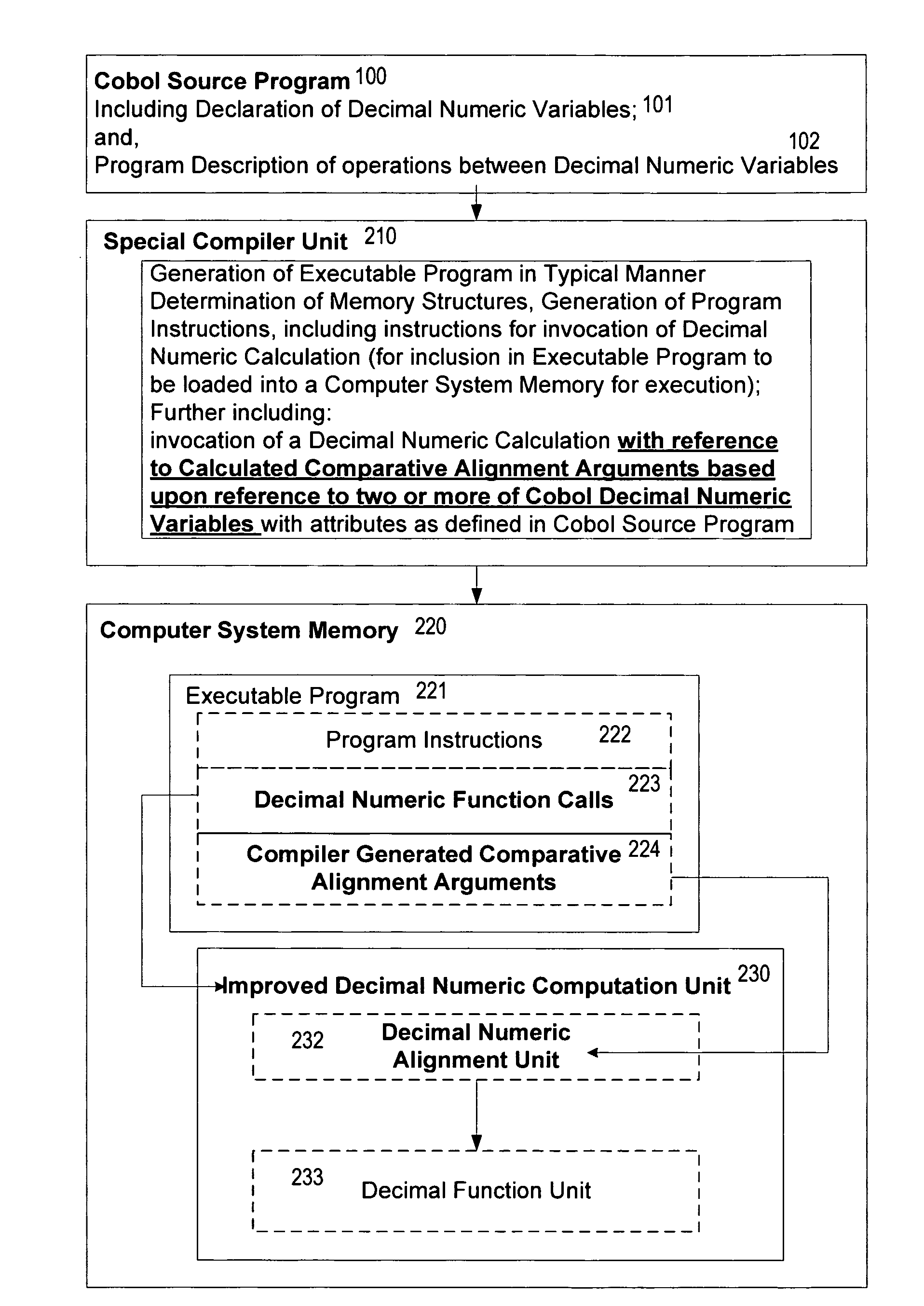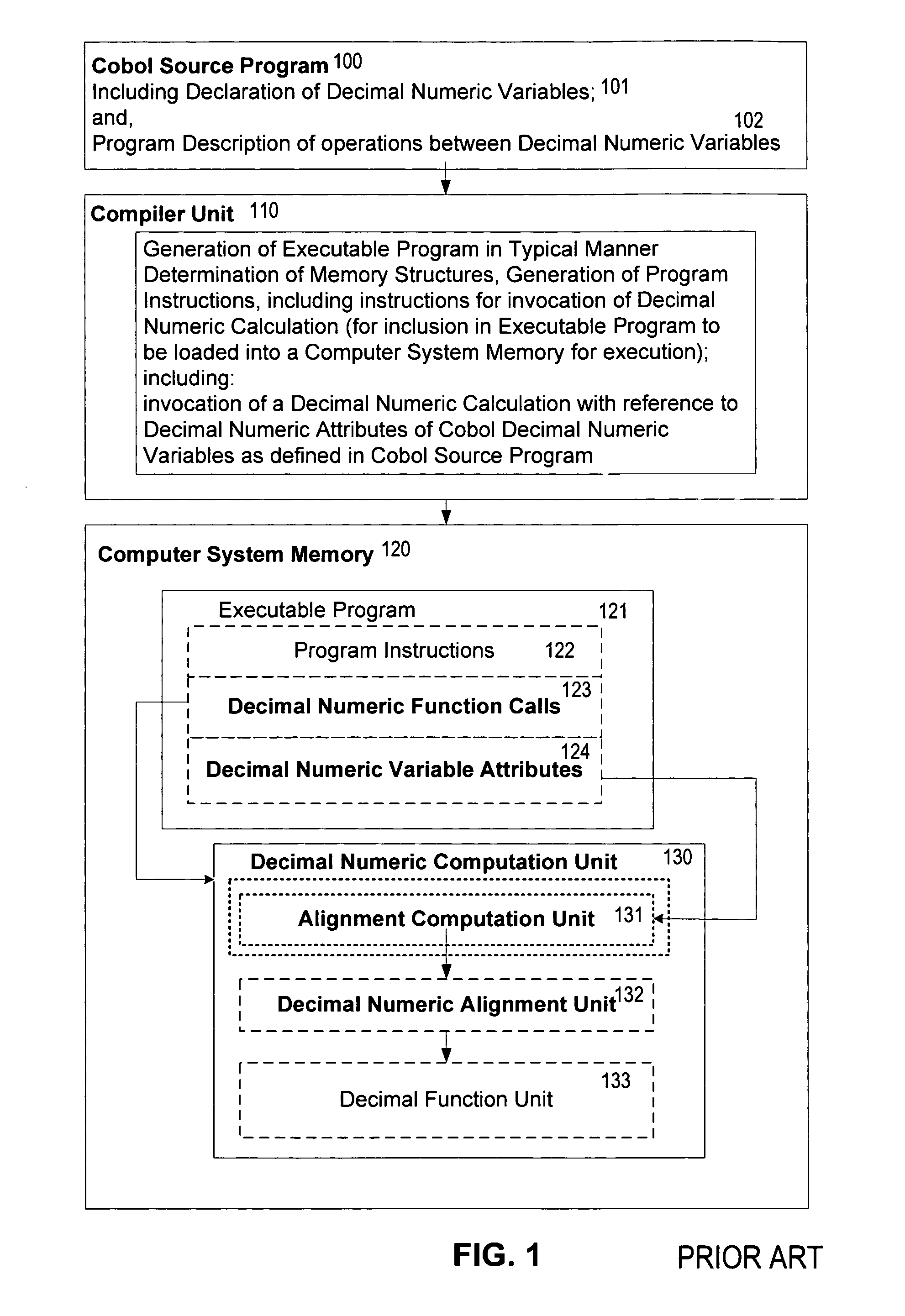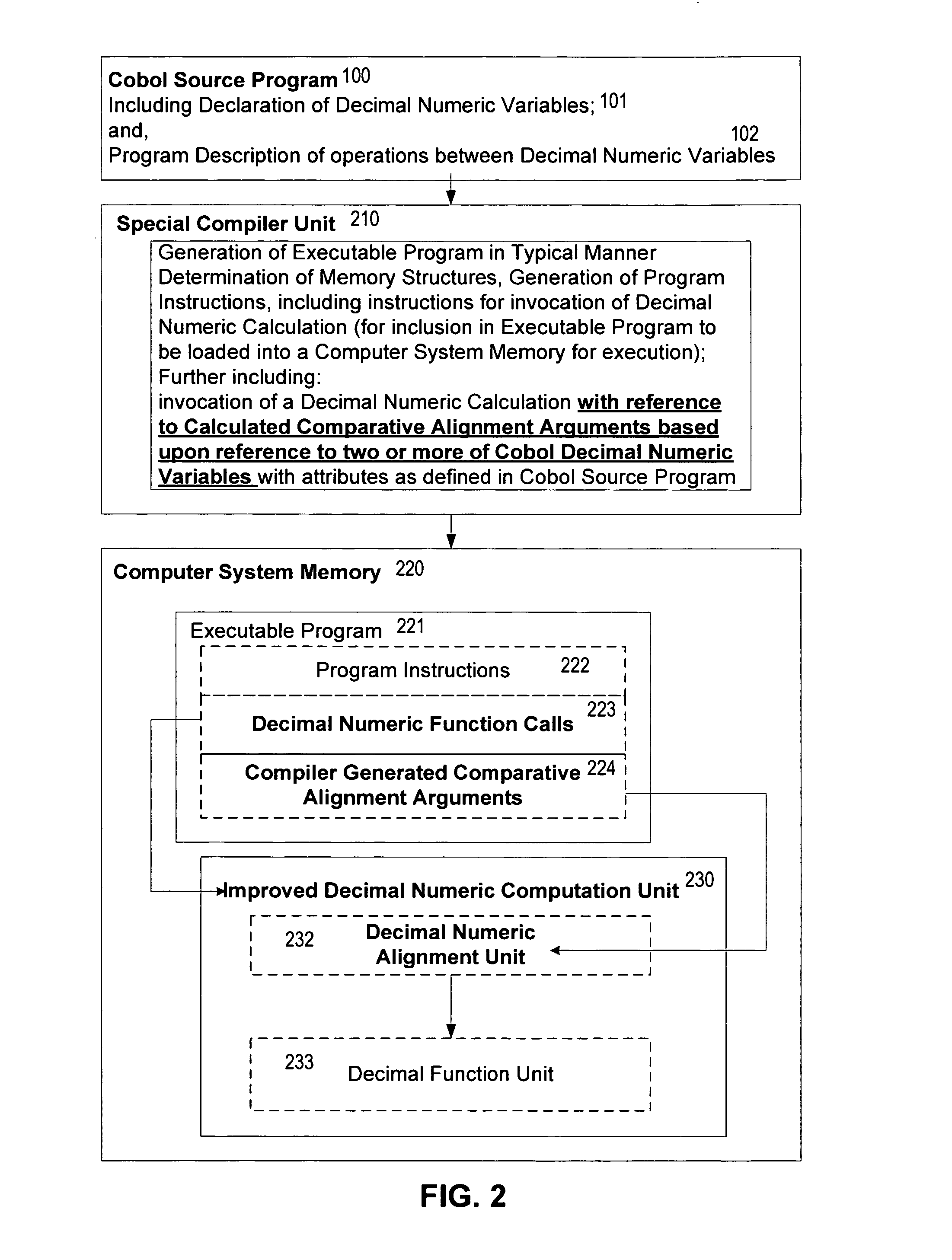[0045]According to an illustrated embodiment of the present invention, an
improved method and system for performing decimal numeric calculations is provided which requires fewer calculations, and fewer alignment and shifting operations in making decimal numeric calculations than in the prior art, especially in relationship to decimal numeric variables and operations implemented in the
COBOL high-level
programming language. This improvement is made by providing, to
execution unit such as a library
subroutine, an argument
list which describes alignment comparison information instead of just “alignment” information. That is, the decimal numeric computation library subroutine is called with an argument
list that includes “alignment information” that describes directly how to align the operands based upon comparison of the specified alignment of the operands rather than providing the specified alignment of the operands independently to the subroutine, and requiring the subroutine to perform the work of comparing alignments and determining how to align the operands.
[0056]This improved decimal execution subroutine provides for
improved performance by including in the arguments “to” the subroutine, alignment information based upon comparison of two or more of the decimal operands. In the above
list, each of the input arguments relating to decimal numeric input operands labeled “c”, “d”, “g”, and “h”, and input arguments relating to a decimal numeric output
operand “k”, and “l”, are based upon comparison of the attributes (e.g. alignment and length) of two or more of the decimal operands referenced by arguments “a”, “e”, and “i”. When this execution subroutine is called, during execution, the
processing necessary to perform the required decimal numeric computation is reduced because the alignment computation operations have been previously performed by the compiler at
compile time, rather than having to be repeatedly performed by the subroutine each time the subroutine is called at run time itself as in the case of the prior art.
[0057]The execution subroutine is typically used in conjunction with a specialized compiler. That is, according to the teachings of the present invention, the specialized compiler is used to process an input program such as a
COBOL source program, with the source program including
declaration of decimal numeric variables, and specification of arithmetic operations between those numeric variables. Input is provided to the compiler that provides with a complete description of the “variable type” as described in the source program, with variable type including characteristics (or attributes) such as memory storage space, alignment,
storage type (such as packed or unpacked), length of the data, and scale factor. (This list is illustrative, and the variables may include either more or fewer attributes in
actual practice). Given a specific arithmetic operation to be performed between two or more “input” operands so as to produce and store results into an output
operand area, and a description of the variable type for each input
operand, and the output operand, the compiler compares the variable type descriptions and generates in the compiled output, a call or invocation of a specialized decimal numeric subroutine which utilizes alignment comparison information provided by the compiler that is based upon comparison of the variable types, eliminating the need for performing a comparison or multiple comparisons at run time by mechanisms included within the subroutine itself. That is, calculation or computation operations necessary to complete the decimal
arithmetic computation that depend upon alignment and comparison of the decimal variable types are done at
compile time rather than at run time. This eliminates the need for these calculations to be done repeatedly at run time, each time the decimal numeric computation is performed and therefore is able to reduce the amount of the time spent in performing the decimal numeric computations during execution of the program (run time).
[0058]As an example, consider adding two decimal numeric operands that are each represented in memory as 10 decimal digits including two digits after the decimal to produce an 11 decimal digit result that also includes two digits after the operand. In the prior art, this decimal numeric operation would be performed by a call to a decimal numeric add subroutine with an argument list that provides description of the two input operands and their types, and the output operand and its type. The decimal numeric subroutine would examine the types of all operands, determine how to align the operands for addition, perform the alignment and any padding on the left and right of digits to make the two operands the same size, perform the addition, and then store the result, possibly with added digits of zeroes for padding on the left or right, or truncation of digits, all depending on the type of the output operand. With application of some aspects of the present invention, this simple addition can be performed with a call to a specialized subroutine that in large part does nothing except perform the addition and store the results since the input operands are already aligned, and the output operand is precisely the right size to hold the result of the addition (one extra digit on the left for a possible carry). Any code within the subroutine for doing alignment or padding would be given, by the compiler, values indicative of no alignment or padding necessary so that the code for doing this work at
execution time is skipped entirely, and the actual addition computation is thus performed without
delay. As a further improvement, storage of the results of the addition is also made directly into the memory space of the output operand variable, rather than storage into temporary or intermediate memory, with
resultant savings in time.
[0066]There are many variations on how decimal arithmetic is performed by various execution units implemented in
software or hardware in current computing devices and by
software subroutine libraries. Applying one or more principles of the present invention provides improvement in performance by providing description of the input and output operands to a decimal computation apparatus or software subroutine so as to eliminate need for one or more calculations at run-time which are dependent on comparison of the characteristics of one or more of the operands. Specifically in one illustrated embodiment, comparison of alignment, or alignment of decimal point, is made by a compiler and provided to the computation apparatus or subroutine, rather than making that computation or comparison at run-time. Additionally, the method and system of the present invention provides for the simplification of the software subroutines required to execute decimal arithmetic operations.
 Login to View More
Login to View More  Login to View More
Login to View More 


